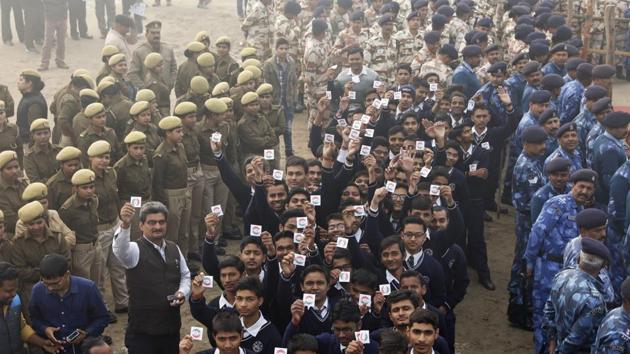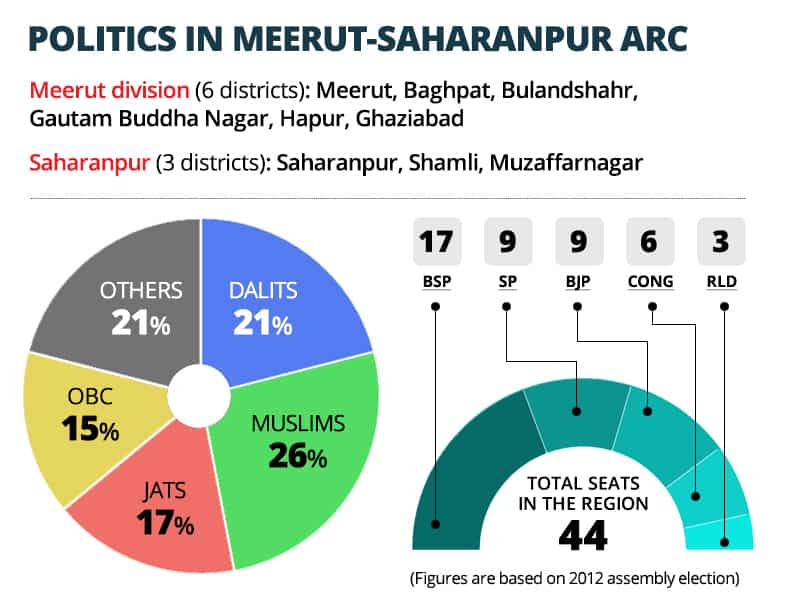From the heartland: Caste, religion and Muzaffarnagar model of politics in UP
Probing the minds of people at a tea shop in western Uttar Pradesh, finding out litany of their sufferings.
The sugarcane fields of western Uttar Pradesh are loaded with the luscious crop, which wave as the wind wafts, but the electoral joust has raised the temperature all around. Some talk of social polarisation, others of social indifference and severance. The apocalyptic ‘Muzaffarnagar model’ of 2013 continues to haunt people. It impacted the 2014 Lok Sabha elections but whether it would impact the 2017 polls to the assembly--no one can predict still.

I was a party to a very passionate debate in the interiors of Muzaffarnagar at Lalukheri. In a tea shop at Sisauli tri-junction, I tried to probe the minds of a multitude of people sipping tea. It took a while for them to shake off their reservations and down their guard. But what followed was a pouring of their heart--the litany of their sufferings, their pain and suffocation just exploded.
An elder said the normal trend in these parts has been to flow with the tide, but the last time people did that, the result was painful. “I have undergone a bypass and I can’t queue long enough to vote. I queued up before a bank for long hours to return without cash. My son is to be married. Now you tell me, what do I do next and how,” he said.
A young man who overheard the conversation reacted violently, “My entire savings have been seized. We heard the bank had been replenished with cash after eight-ten days. I rushed there, only to find that the currency had run out. I do not have a penny in hand.”
Even before I could react, a third voice rose above the din, this time full of anger. “What are you talking about? We are voting to elect an MLA. What you talk of is plain nonsense, first talk of the issues facing the state. My MLA never does reappear, once he wins it”.
What about the MP, I wonder and pat comes the reply. “He too is absconding”. Most people here debate in anguish how Netaji and his minions just gave up the people--whether they won, or lost.
I thought the debate on demonetisation and its impact was over, when a gentleman challenged me, saying, “Forget the banks. Let’s visit an ATM. Dogs wallow in them.” That set off a general commotion--some for demonetisation, some against. Demonetisation does shadow the general debate, wherever one goes, though whether it would colour this election is not a given.
To take the debate off it, and further, I cautiously probed, whether they got the right price for their crops. The answer was cryptic, bitter.
“Farmers here have been drowned in debt. The state promises loan waivers and promises fresh loans. But most have been caught in a vicious cycle of banks and moneylenders. It would have been better had we got a good price to clear our debts and were able to add broad base farming activity,” said one. This area of western UP is known for the vicious web of private money lenders and the trauma of those caught in their web.

See the irony. This is the area which sprung the politics of late Chaudhary Charan Singh. Many still mistake him for just a Jat leader. It’s true that the Jats constituted his major vote base but he was the first to raise the issues of farmers, and over generations--right from the streets up to Parliament. This is again the heartland of the towering kisan leader Mahendra Singh Tikait whose one call was enough to make people spill into the streets. The issues then were as complex, as they are now.
Leaders have come and gone. Elections too have come and gone. The state is in for another election but it would seem there is nobody to debate the issues of farmers any more. I asked, why is it so?
The invectives which followed stunned.
“Why don’t you put the issues before people who ask for your votes with as much stringency?” I asked. The answers were many, the summary of which largely was that politicians just care for their own community, caste and creed. They hardly have the time or patience to talk to the last man.
Custodians of caste and religion are now out with different slogans of ‘development’, while dwelling on ‘caste configurations’ or raising the bogey of ‘faith in danger’.
How much does all of this impact the voters? To understand, I ventured to ask people how they personally reacted to religion, caste and development, and which of them mattered most.
They reacted with intelligence--it has to be security, then development. It does not require much to understand that by ‘security’ they emphasise caste and religion. That could only reinforce the Muzaffarnagar model of politics that so shaped the past elections in these parts.

(Shashi Shekhar is editor-in-chief, Hindustan. Translated from the original Hindi.)
(The author tweets @shekharkahin.)
Get Current Updates on India News, Election 2024, Mukhtar Ansari Death News Live, Bihar Board 10th Result 2024 Live along with Latest News and Top Headlines from India and around the world.



